

Furtwängler & Hammer Imperial Cathedral Königslutter - A Kingly Instrument for a Royal Worship Space
2019-03-01 - Sample Set SpotlightFurtwängler & Hammer, No. 286 - A Masterpiece Saved!!!
The grand organ in the Kaiserdom, Königslutter, Germany, was built by the firm of Furtwängler & Hammer as No. 286 in the year of 1892. It is a masterpiece of the period, now fully restored to its original state, matching the splendor and majesty of the Imperial Cathedral itself, also fully restored.
In this Sample Set Spotlight Review, I've "illustrated my opinions" by inserting links to over 20 recordings that I did on this instrument. Rather than going into more details here about what I used, or what stops I am featuring, the links to each of the recordings will provide the reason that I chose a particular piece, any registrations of interest, or other important information there.
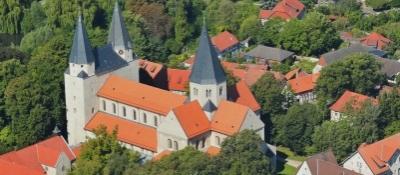
The Kaiserdom, Königslutter
The Imperial Cathedral in Königslutter (Germany) is one of the most important Romanesque buildings in Germany. It was founded in 1135 by Emperor Lothar III as a Benedictine abbey church and burial church for himself and his family. After Lothar's death, the cathedral was completed under Henry the Lion. It is a cruciform basilica of enormous dimensions for that period, measuring about 75 m long and 18 m high.
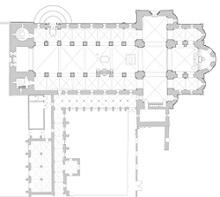
Kaiserdom Floor-Plan
http://www.contrebombarde.com/concerthall/music/31807
Six Preludes for Organ, No. 4 (Lento) - Ernest Bloch

Kaiserdom in Winter
At the end of the 19th century an extensive restoration of the church was decided upon. This also included a new painting of the interior of the church, as the medieval church painting had been painted over with yellow paint. The artistic paintings from this restoration are today considered an important document of the end of the 19th century.
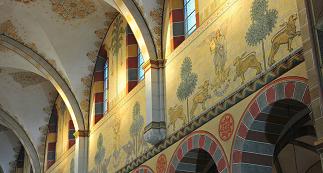
Elaborate decorations of the walls of the Nave
http://www.contrebombarde.com/concerthall/music/31808
Six Preludes for Organ, No. 5 (Un poco animato) - Ernest Bloch
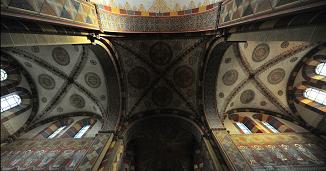
The spectacular ceiling, showing the vault of the Central Tower
http://www.contrebombarde.com/concerthall/music/31809
Six Preludes for Organ, No. 6 (Moderato) - Ernest Bloch
The Imperial Cathedral Königslutter is one of the outstanding Romanesque buildings in Germany. It is considered to be the Saxon counterpart to the Salian cathedral in Speyer. It's origins lay with Emperor Lothar.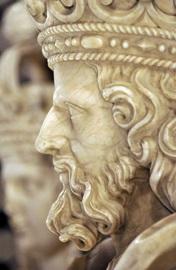 Emperor Lothar III http://www.contrebombarde.com/concerthall/music/31851 Album-Leaf - Edvard Grieg Lothar, born in 1075, came from Saxon aristocracy. His home was the region between Braunschweig and Helmstedt. He is called "von Süpplingenburg" after the ancestral home of his family. His marriage to Richenza of Northeim earned him extensive ownership and power. From 1106 Lothar was Duke of Saxony. 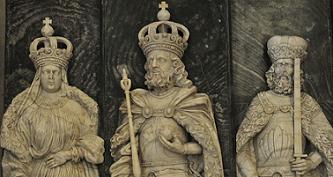 Queen Richenza, Emperor Lothar, Duke Henry the Proud http://www.contrebombarde.com/concerthall/music/32007 Tennessee Twilight Time - Harvey B. Gaul http://www.contrebombarde.com/concerthall/music/32009 Ashokan Farewell - Jay Ungar |
In the summer of 1135 Emperor Lothar III laid the foundation stone for the memorial church of his family and donated a new house monastery, which he occupied with Benedictine monks. The convent headed by Abbot Eberhard came from the monastery Berge near Magdeburg, a center of the Hirsau reform movement in northern Germany. The church was consecrated to Saints Peter and Paul.

Early woodcutting of the Imperial Cathedral
The imposing appearance of the building, the excellent masonry quality of the eastern parts in particular, the wide vaults in the choir and transept and the Italian architectural sculpture prove the emperor's high standards for his church. In the history of architecture and art, the imperial cathedral has an outstanding position.

Part of an early drawing
Due to numerous relics and a supposedly miraculous image of Mary, but especially because of the papal entitlement to grant generous indulgences, Königslutter developed in the Middle Ages into one of the most important places of pilgrimage in northern Germany. Every year, thousands of pilgrims flocked to the Elm ("Lattersche Fahrt") on Peter and Paul's Day (June 29), the feast day of the two patron saints of the church. Many of them came from far away, from Thuringia, the Rhineland or from the Baltic Sea.

A pilgrimage
http://www.contrebombarde.com/concerthall/music/32209
Wachet auf, ruft uns die Stimme - Johann Gottfried Homilius
At the end of the 19th century, the Kaiserdom was in such a bad condition that renovation was inevitable. When removing the thick yellowish lime paint, which covered all wall surfaces of the interior, medieval paintings were discovered. At the suggestion of the regent Prince Albrecht of Prussia, the decision was made to completely redesign the church space, and the contract went to the architect, building historian and museum director August Essenwein (1831-1892), who had made a name for himself through numerous important restoration projects in Germany. On the basis of the uncovered paintings in the choir and in a few other places he developed in the sense of a 'creative' preservation of monuments an overall concept for the remodeling of the interior. The aim of Essenweins was a "stylish" (which I think means "historically accurate") restoration.
http://www.contrebombarde.com/concerthall/music/32213
Nun komm der Heiden Heiland, BuxWV 211 - Dietrich Buxtehude

Wall Decorations
http://www.contrebombarde.com/concerthall/music/32214
Es ist ein Ros entsprungen, Op. 122, No. 8 - Johannes Brahms

Imagery - rich and colorful
In connection with the redesign of the interior according to a concept by August Essenwein the furnishings were restored and supplemented at the end of the 19th century. These include the jeweled floor in the East end, the altars, the cross, the pulpit, the doors, benches, pendant lights, song pointer, all window glazing and the organ. Overall, the decoration and the furnishings of the imperial cathedral represent an outstanding and unique in its historical completeness.

The richly-colored Angelic Host
http://www.contrebombarde.com/concerthall/music/32215
Advent (First Religious Suite) - Pietro Yon

Christ in Majesty, in the Apse ceiling, above the High Altar
In the course of this restoration a new organ was installed as well. This organ was built by one of the leading German organ building firms of the time, P. Furtwängler und Hammer from Hanover. At that time, this company could already look back on a long tradition of organ building. It was founded in 1838 by Phillip Furtwängler,, later his sons took over the business. In 1883 the organ builder Emil Hammer became a partner in the company and the name was changed to P. Furtwängler and Hammer.
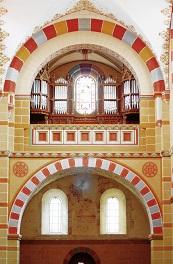
Furtwängler and Hammer, No. 286, built in 1892
http://www.contrebombarde.com/concerthall/music/32317
Wachet auf, ruft uns die Stimme, Op 68, No, 5. - Flor Peeters
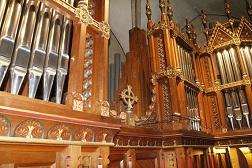
The case work with elaborate designs and polished pipes
The organ corresponds to the romantic sound ideal of its time. Its sound is characterized by numerous stops in a variety of timbres at 16', 8' and 4' as well as by the typical degressive terrace dynamics, in which the volume decreases from the lower manual upwards. Thus, for most stops there is an equivalent with a graded sound volume in each manual. This enables an almost smooth, "stepless" dynamic climax and anticlimax, which according to the german-romantic tradition is performed using the labial stops.

Emperor Lothar
The company Furtwängler und Hammer acquired an excellent reputation through the high quality of its organs, many of which still play today.
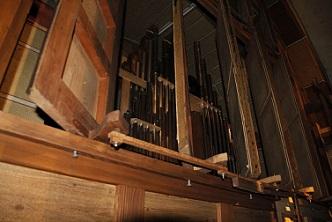
The Echowerk (Note the "swell box")
http://www.contrebombarde.com/concerthall/music/32040
Caprice, Op. 96 - William Faulkes
The organ in the Kaiserdom was built in 1892 as Opus 286 and today has 44 stops on 3 manuals and pedal. The key action is mechanical-pneumatic, in the Hauptwerk division a mechanical action controls pneumatic Barker levers, which in turn open the valves of the organ pipes mechanically. This type of action was also used by Aristide Cavaillé-Coll, it allows a very precise and effortless playing, but there is no direct mechanical connection between the keyboard and the valves. This organ is an instrument with a cone valve chest, a typical wind chest construction of the German-Romantic organ building style, in which all the pipes of a stop are placed on a stop-channel and controlled by individual valves. In contrast to the slider chest construction, not only one valve per key is required, but for each stop one valve per key is needed. Hence - in contrast to the slider chest - every single pipe receives the full wind.
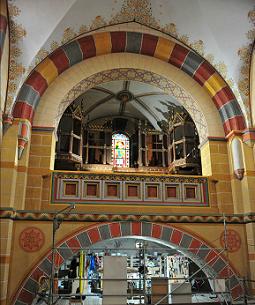
The organ case during the restoration of the building
http://www.contrebombarde.com/concerthall/music/32039
Petit Prélude (Aria) - Joseph Jongen
In the 1940s the German Orgelbewegung negatively altered this instrument along with many others, and some changes were made in order to come closer to the baroque sound ideal prevailing at that time. For example, the Clarinette 8' was replaced by a Krummhorn 8', and the Progressive Harmonica (Mixture) in the Seitenwerk (manual II) was replaced by a baroque Scharff. In 1984 the mechanical action was replaced by an electric one.
http://www.contrebombarde.com/concerthall/music/32254
Ben moderato (Au pied de l'Autel, Book 2, No. 1) - Guy Ropartz

Most of the pipes were removed during the building work
The thing that actually saved the organ was the fact that the building itself had fallen a drastic state of disrepair. The importance of the building led to its restoration, and this, in turn to the saving restoration of the organ.
In the 1990s, considerable damage was found to the paintings in the church and an Kaiserdom extensive renovation was planned. The beautiful painting of the 19th century was completely restored to its original color. In the course of this comprehensive renovation of the church in the years 2008 to 2010, the organ was also subjected to a thorough overhaul. It was restored to its historical sound of 1892 by the organ-building company Hartwig Späth (Freiburg). During the electrification of the organ in 1984, the components of the mechanical action had fortunately been stored, so that the original mechanical-pneumatic action could now be restored and reinstalled.
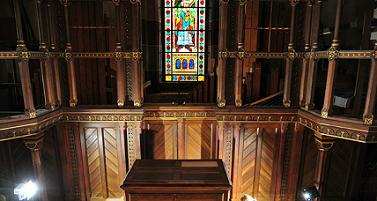
Only the largest pipes at the rear remained during the building restoration. The console was not removed.
After this restoration, the large Furtwängler and Hammer organ is now considered an outstanding sound monument and one of the most important romantic organs in northern Germany. It is a true "time capsule" and monument of sound.
The Furtwängler Organ Building Tradition
If you are like me, you know little about the Furtwängler tradition of organ building. I do know the name, but not much else, so, let's see if we can come up with some historical facts and insights into the foundation, growth, and advancements of the company.
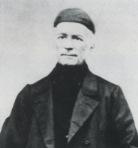
Philipp Furtwängler was born on April 6, 1800. Originally a watch dealer by profession, he soon became a maker of tower clocks. In 1826 he married and settled in Elze, near Hannover. In 1838 he founded the firm Philipp Furtwangler.
http://www.contrebombarde.com/concerthall/music/32254
Ben moderato (Au pied de l'Autel, Book 2, No. 1) - Guy Ropartz

Colors, vibrant and glowing
His marriage contract already mentioned that there were organ parts in repair at his workshop, and these were likely parts for mechanical organs, but with his mechanical talents and interest in the occasional repairing of these clock organs, he found his true calling, and decided to become an organ builder. His interest as a mechanic was so aroused by the occasional repairs that he decided to build the organ and in 1838 his business, Philipp Furtwangler, was registered in the district court at Elze.
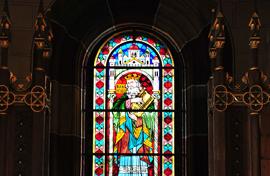
Emperor Lothar in the window "between" the organ
In 1854, Furtwängler took his eldest son, Wilhelm, into the company, renaming the business as Philipp Furtwängler & Sohn. In 1862, his youngest son, Pius, joined the firm, which was now known as Ph. Furtwängler & Söhne.
By the time that Philipp Furtwängler died on July 9, 1867, his business was thriving, employing about 15 men, and highly regarded.
http://www.contrebombarde.com/concerthall/music/32256
Allegro moderato (Au pied de l'Autel, Book 2, No. 3) - Guy Ropartz
Because the line Furtwängler remained without heirs, Pius Furtwängler took the famous organ builder, Adolf Hammer as a partner after the death of his brother William in 1883. It was at this time that the firm relocated from Elze to Hannover.
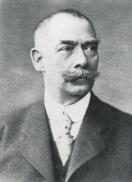
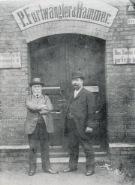
Adolf Hammer Furtwängler & Hammer
Adolf Hammer was born on April 6, 1854 in Herzberg, and had been an apprentice in the workshop of Furtwängler, where he acquired a comprehensive knowledge. Before he became a partner of the company, he was self-employed in the Wroclaw area.
The company was now called: P. Furtwängler & Hammer - Hannover.
http://www.contrebombarde.com/concerthall/music/32259
Moderato ma resoluto (Au pied de l'Autel, Book 2, No. 6) - Guy Ropartz
In these years of flourishing organ construction, new ideas and technologies were adopted and implemented. There were organ works with first mechanical, then pneumatic actions. All instruments and structures were built with selected materials and were admired for their lightness and precision. Some of these organs are still in existence, and some still play today: with original action and wind systems.
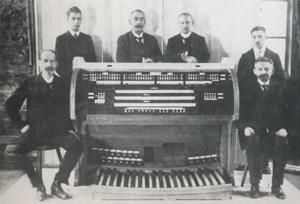
Stadthalle Console
In 1914, the firm built a large organ, which was admired by the experts, and installed in the Stadthalle in Hanover. It had 124 sounding stops and 117 individual playing aids, 8225 pipes, and was the largest organ from the firm. Highest recognition was given to the precise tube pneumatics with quadruple staggered wind pressures also to the remote work 30 m away. The technical aspects of the instrument were excellent, had many orchestral effects, and wide-ranging dynamics, from "the most tender ppp to the strongest fff". The organ also featured a large combination mechanism, unusual for the day.
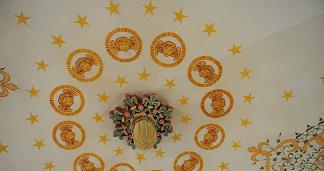
Elaborate ceiling decorations
http://www.contrebombarde.com/concerthall/music/32210
Wachet auf, ruft uns die Stimme, Op. 78, No. 18 - Sigfrid Karg-Elert
Sadly, the instrument was completely destroyed during World War II.
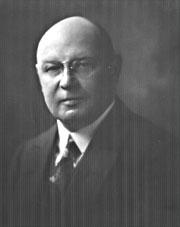
Emil Hammer
In 1937, the nephew of Adolf Hammer, Emil Hammer, was born in Wesermünde, and became the sole owner of the company founded by his uncle. The company name was now: Emil Hammer Orgelbau. Finding an appropriate space for the factory was difficult, but the firm was able to take control of the former ammunition production plant of the company A. Nobel in Empelde, near Hannover.
http://www.contrebombarde.com/concerthall/music/32797
Pastorale - Everett Titcomb
The reconstruction of the first organ works after the war were hindered by extreme material shortages, not to mention the many different views and opinions about the construction of a new organ. Due to lack of material and money, many projects were greatly slowed or even stopped before ever getting started.
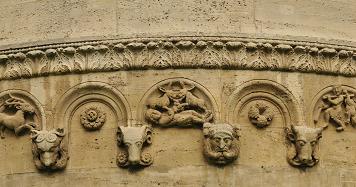
Carved stonework on the pillars in the Nave
After the death of Emil Hammer in December 1958, his grandson Christan Eickhoff, born on December 23, 1935 in Shanghai, took over the company - the old company name Emil Hammer Orgelbau, Hannover - remained.
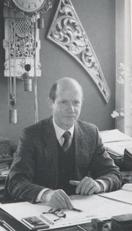
Christian Eickoff
After the years of apprenticeship and traveling in Hannover (E.Hammer), Zurich-Maennedorf (Th.Kuhn AG) and Copenhagen (Axel Starup), Christian Eickhoff began his work in 1961 with 25 skilled employees. He first worked in the workshop at Empelde, and continued at Hannover the company engineered by his grandfather. Here, too, the operational processes were cramped, so that they decided to a new workshop, which was moved to Arnum, Hoher Holzweg in January 1966.
In 2007, Christian Eickhoff sold the company to the organ construction company Reichenstein. Georg Schloetmann, employed by Orgelbau Hammer since 2004, assumed control of the management of the workshop.
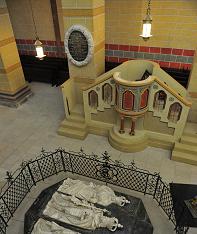
The Pulpit and the Baroque tomb of Emperor Lothar, Queen Richezza, and Duke Henry
After a period of reorganization, the Hammer workshop moved to Hiddestorf in 2008, now occupying the former workshop of the organ builder Franz Rietzsch.
In May 2011, the workshop split from the organ construction company Reichenstein, with Malgorzata and Georg Schloetmann assuming control of their own business.
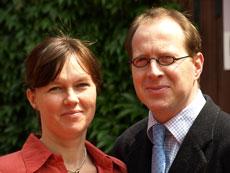
Malgorzata and Georg Schloetmann
Today, in addition to smaller new buildings, the restoration and reconstruction of the organs built by Furtwängler & Hammer is the main focal point of their work.
http://www.contrebombarde.com/concerthall/music/32918
Matins, HWC 183, No. 1 - Healey Willan
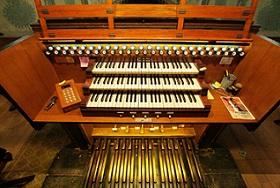
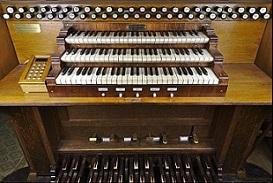
Shots of the Console - Real on the Left / Virtual on the Right
http://www.contrebombarde.com/concerthall/music/32919
Evensong, HWC 183, No. 2 - Healey Willan
Furtwängler und Hammer, No. 286, 1892 in detail
The large organ in the gallery is regarded as an outstanding monument of sound and is one of the most important surviving romantic organs. As already mentioned, a "symphonic sound" can be achieved through the use of many fundamental and string registers. Like the orchestra, the sound continuously increases in volume without significantly altering the timbre.
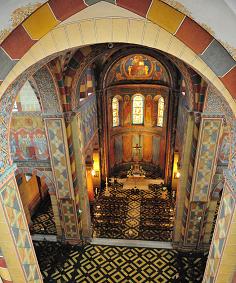
Looking down at the Sanctuary and High Altar
The restoration carried out from 2008 to 2010 by the company Freiburger Orgelbau, Hartwig and Tillman Späth has returned the instrument to its original state, after it had been significantly altered in the 1980s, especially in the restoration of the action between keys and pipes.
http://www.contrebombarde.com/concerthall/music/33055
Andante moderato, Op. 18, No. 4 - Alexandre Francois Pierre Boëly
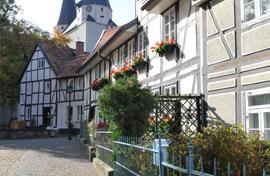
The lovely "Neighborhood" of the Imperial Cathedral
The Organ in Detail - Division by Division
Now that we've learned a fair and goodly amount about the history of the The Imperial Cathedral in Königslutter and of the Furtwängler and Hammer firm, builders of the important and historic instrument housed therein, let's spend a little time going through each of the divisions.
The Hauptwerk, or Great Organ, is rich and full. Not overly aggressive, the sound is dense, but the upper-work adds a good sense of brilliance, but never in a harsh or exaggerated way. The flutes are varied and beautiful, and stops such as the Großgedeckt 8'are very versatile because of their gentle presence. I used it as a solo voice, for accompaniment, and even coupling it to the Pedal, when I wanted a softer 8' sound there. The Principal chorus is clean and appealing, but maintains the romantic idiom that the sound is based upon. A voice such as the Gambe 8' is an outstanding example of this type of stop. It is quite "keen," and can make itself heard as a solo color, and can also be combined with the other 8' stops to make that characteristic "German romantic" sound that works well in many pieces of the period. The 16' stops add a lot of weight, and really support the full sounds. The Trompete 8' is big enough to serve as a solo voice or as a chorus reed, where it really fills out the sound.
http://www.contrebombarde.com/concerthall/music/32208
Wachet auf, ruft uns die Stimme, BWV 645 - J. S. Bach
One of the limitations of this organ is the couplers. Only the Seitenwerk can be coupled to the Hauptwerk, and this is unfortunate, as having the ability to couple the Oboe and Geigenprincipal of the Echowerk into the chorus would really complete the effect, but, such is life!
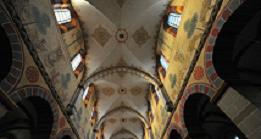
Another look at the spectacular ceiling and upper-walls of the Nave
Speaking of the Seitenwerk, it's a very complete "Positif or Choir Organ". Incidentally, when I translate the word "seitenwerk," I get "page factory," so, that can't be right!
The Quintatön 16’ is "nasal" as you would expect, and it is certainly not a heavy 16' stop. The Principal is sturdy and with color, and the Fugara is sharp and bright. The Doppelflöte is big and full, and probably the "biggest" solo flute of the instrument, while the Gemshorn is small and delicate, but still nicely defined. The 4' and 2' stops are excellent, with the excellent qualities of versatility. The Nazard balances nicely, and the Harmonieflöte 2' is bright and attractive, but it doesn't "do damage" by being shrill. The Progressiv harm. 2-4fachs functions exactly as you would hope, and adds a nice "true mixture" sound to the ensemble. The Clarinette is a "free reed" and has quite a bit of the sound of a harmonium. It isn't the same as an English Clarinet, but is a wonderfully unique solo voice, once you learn how to "manage your touch" will using it. It can also be used in the chorus, and with the mixture, makes a full and bright chorus for you.
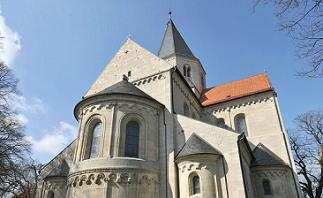
The East end of the Kasierdom (behind the High Altar)
The Echowerk is enclosed and has some truly lovely sounds. The Flöte trav. 8' is a wonderful "open flute" and is quite large. It has many uses. The Lieblich Gedeckt 8' is a wonderful "opposite," and can add much in color to any number of the stops in the division. The Geigenprincipal is sweet, but still weighty enough, and the 4' Violine and Zartflöte 4' are excellent. The strings, at 16' 8' and 4' are rich but soft. The Aeoline 8' adds the "celeste" to the Salicional, and it is very fine, although not at all loud. The wonderful Oboe 8' has color and passion, either as a solo or in the chorus.
Remember though that this is an "Echowerk" and NOT a Swell! It can not be coupled through to the Hauptwerk, but can be coupled to the Seitenwerk.
It is unfortunate that this, and many other German organs of the day, do not have a real "Swell division." However the sounds that this instrument produces, combined with the glorious acoustic, is a BIG compensation!
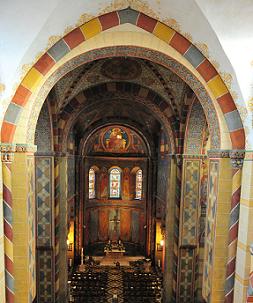
View of the Sanctuary and High Altar from the organ console
The Pedal is substantial, but basically a "fundamental" division. The Subbaß 16' is round and full, and not soft. The same can be said of the extended Flötbaß 8'. If you need a really soft pedal, you might try coupling the 16' Bordun of the HW, with or without the Großgedeckt 8'. The Cello 8' and Violon 16' are fairly large and a "stringy" in the best sense of the word. The Prinzipalbaß 16' is substantial, but without the true weight of an English pedal. The Oktavbass 8' and Octave 4' are extensions, I think, but work well. The Quintenbass 10 2/3' can do the work of a "fake 32'," especially being somewhat "disguised" in the generous acoustic. The Posaune 16' is large and smooth, with color, but correctly without the "heat" of a French reed. The Trompetbaß 8' goes with it perfectly, and will really fill out the biggest bass lines. The full Pedal is impressive, but is not a "thunderer," which would really be not "fit" into the overall tonal mix, considering the refined and noble sound of the full organ. The only coupler to the the Pedal is that of the Hauptwerk.
I. Hauptwerk C-f3
- Principal 16'
- Bourdon 16'
- Principal 8'
- Großgedeckt 8' #
- Gambe 8'
- Hohlflöte 8'
- Octave 4'
- Gemshorn 4'
- Gedecktflöte 4'
- Quinte 2 2/3'
- Octave 2'
- Cornett 3-4f.
- Mixtur 3-5f.
- Trompete 8'
II. Seitenwerk C-f3
- Quintatön 16'
- Principal 8'
- Fugara 8'
- Gemshorn 8'
- Doppelflöte 8'
- Rohrflöte 4' *
- Viola 4' *
- Nazard 2 2/3'
- Harmonieflöte 2'
- Progressiv harm. 2-4f. *
- Clarinette 8'
(durchschlagend)
III. Echowerk C-f3
- Aeoline 16' #
- Geigenprincipal 8'
- Flöte trav. 8'
- Lieblich Gedeckt 8'
- Salicional 8' #
- Aeoline 8'
- Violine 4' *
- Zartflöte 4'
- Oboe 8' *
Pedal C-f1
- Principalbass 16'
- Subbass 16'
- Violon 16'
- Quintenbass 10 2/3'
- Octavbass 8'
- Flötenbass 8'
- Cello 8'
- Oktave 4'
- Posaune 16'
- Trompete 8' *
There are four "presets" or "Trigger Collective Buttons" for: Tutti, Forte, Mezzoforte, and Piano.
The registers marked with a * were changed, but were returned to the original condition in the course of the restoration.
The registers marked with a # were lost, and were recreated according the the original build. In essence, these "new stops" replace the "old ones" that had been removed in the changes that had been made over the years.
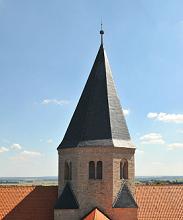
The friendly Central Tower
THE HAUPTWERK EXPERIENCE
The use of this instrument in Hauptwerk is easy, and straight-forward without "issues" and without "bugs" to spoil your experience or upset or ruin your day!
Also, the set is not a hog in terms of RAM usage, and the quality is of the highest throughout.
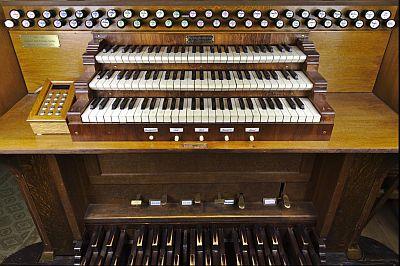
Kaiserdom Hauptwerk Virtual Console
I believe that some have said that the layout of stops is not as "clear" as it could be, but it is in keeping with the actual console, which simply has two L-O-N-G rows of drawknobs above the keyboards. This is not the elaborate console that we see on English instruments, and even more so on American consoles.
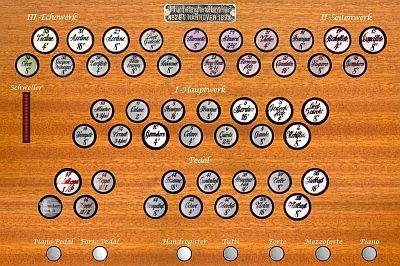
Stop controls for a single monitor arrangement
There are several layouts to choose from, depending upon whether you use one or two monitors. I use one, so my "selection" and "experience of choosing" is always limited, but the choices are clear, should you be fortunate enough to have two monitors at your console.
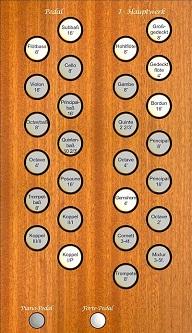
HW stop-screen (left side) for two monitors
In addition to the stops, there is a nice virtual console, which is very like the real console. When I first saw the console, I said to Reiner that I thought it would have been better if the "telephone" had been removed for the photo! However, he pointed out that the "telephone" is the "sequencer" used in the "modern" combination action!
Well, I knew that...;-)
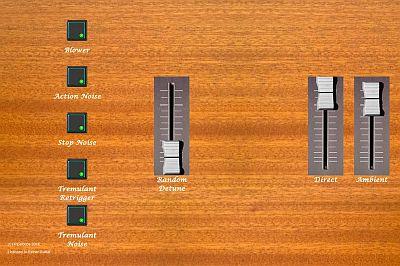
HW slider control for location and other adjustments
There is a simple-to-use slider control, which you can use to set your "listening/playing perspective." In almost all of my recordings, my distance is set at "maximum distance FROM the sound." In one or two cases, I think I moved a little closer, but only slightly. I think it is a real credit to the recordings of the real organ and the production of the sample set that there is excellent clarity, despite the vast acoustic and the distance from the direct sound!
MY CONCLUSIONS
It was pretty clear from my very first "demo-upload" that this sample set was going to attract a LOT of attention, and from what I've seen, ALL of the attention is positive!
The rich and genuine sounds of the instrument, the ease of use and perfection of controls and features, the special colors and gloriously vast acoustical ocean, and a reasonable and highly competitive price, make this a real winner, and if you are looking to add this "type" of instrument to your sample set stable, this is one to DEFINITELY CONSIDER!
Here is a direct link to the Pipeloops page:
http://www.contrebombarde.com/concerthall/organs/view_organ/284
I extend my appreciation to Pipeloops for giving me the chance to play and review this set. THANK YOU, Reiner! I have enjoyed playing the Furtwängler and Hammer organ of the Imperial Cathedral in Königslutter immensely, and look forward to the pleasure of many more uploads in the future.
Like ALL of my reviews, the opinions are my own, based on my experience and are sincere and honest feelings about the organ and sample set being reviewed.
I did receive a copy of this sample set without cost for my review, but I am not paid for this or for ANY of my Sample Set Spotlight reviews.
http://www.contrebombarde.com/concerthall/music/32028
Prelude Heroic, Op. 139, No. 1 - William Faulkes
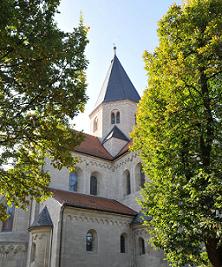
Kaiserdom - Central Tower and side Chapels
A PHP Error was encountered
Severity: Notice
Message: Undefined property: stdClass::$art_pl_link
Filename: articles/view_cat.php
Line Number: 110
Comments